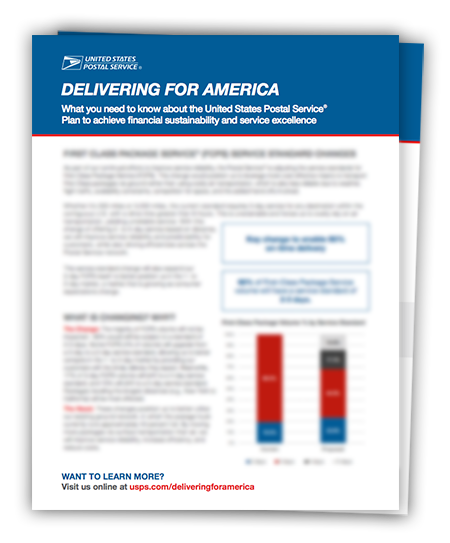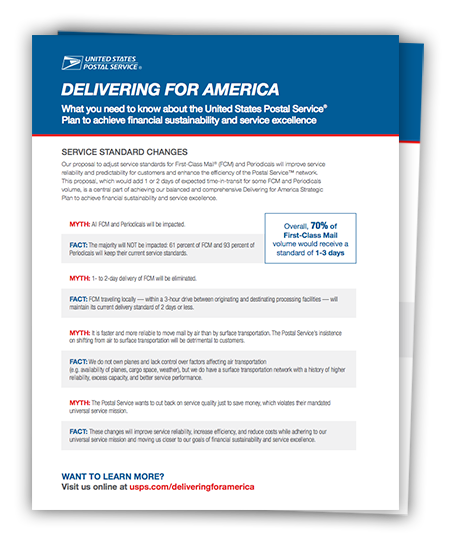Delivering for America
Our Vision and Ten-Year Plan to Achieve Financial Sustainability and Service Excellence
Our plan
The strategies and initiatives outlined in our Delivering for America plan represent our commitment to achieve service excellence, realize cost saving and revenue growth, modernize postal infrastructure and enhance our employees' wellbeing.
Strategic initiatives
Financial sustainability
Our plan enables the Postal Service to achieve a break-even operating performance over the next 10 years.
Through a combination of cost and revenue improvement strategies and regulatory and legislative actions, we can avoid $160 billion in projected losses by 2030.
Since the launch of the Delivering for America plan, we’ve quickly demonstrated the Postal Service’s commitment to becoming financially sustainable. Even with the unexpected burden of inflation, the organization still forecasts we can achieve break-even operations by the end of DFA’s 10-year period.
Service excellence
Our plan preserves our ability to fulfill our universal service mission. This includes visiting every residence and business, with six days of mail delivery and seven days of package delivery, and doing so affordably, reliably and securely.
By using best-in-class logistics practices, we intend to drive efficiency and service performance improvement to fuel revenue growth and customer retention. Most importantly, our plan establishes a new operating model that dramatically improves on-time delivery performance. Since the launch of our Delivering for America plan, we’ve already reversed years of declining reliability and are closing in on the goal of meeting the primary objective of 95 percent on-time performance across all mail types.
Since mid-2021, on-time delivery performance has improved significantly and consistently across all product categories, and by the end of FY2022, our on-time performance was the highest it had been in five years.
This achievement gave the White House the confidence to entrust the Postal Service with distributing COVID-19 test kits to the nation. Our commitment to election integrity has been reinforced, too, with the 2022 elections showing once again that election mail was delivered securely and on time.
Investment
We will invest $40 billion in our people and infrastructure over 10 years. This includes investments across our delivery, processing and retail operations with new information technology systems, parcel sorting equipment, mobile devices for carriers, as well as a faster pace of innovation in our product and service offerings.
We’ll support our employees by modernizing our vehicle fleet, and invest in tools, training and systems to improve safety, environmental stewardship and workplace experience. These investments will enable us to modernize the Postal Service and meet the changing needs of our customers.
Strategic investments and operational improvements established under the plan have stabilized the permanent workforce, added additional storage capacity and resulted in the purchase and deployment of 348 new package sorting machines across our network. These technological upgrades have increased daily package processing capacity to 70 million.
Key progress milestones
After two years, we’ve made significant progress on key strategic initiatives across the organization, as highlighted below. Also, see our DFA annual progress reports.
Network modernization | Reform Act | Simplified shipping | Postal rates | Service standards | Operations
Network modernization
Nearly $7.6 billion of the plan’s $40 billion self-funded investment budget is committed to creating a modernized postal network while maintaining high Service Standards and meeting our mandate to deliver six days a week to nearly 165 million addresses.
Larger, centrally located sorting and delivery centers — many of them newly built for our needs — will provide faster and more reliable mail and package delivery over a greater geographic area. Our new regional processing and delivery centers — over a million square feet and also purpose-built — will enable more effective workflows that simplify the movement of all classes of mail and packages.
Electrifying America’s oldest and largest federal fleet
Modernizing our mail delivery fleet is a critical part of our Delivering for America plan. From the start, we committed to purchase the most environmentally sustainable vehicles for our ground fleet, with the understanding that this multi-billion-dollar investment would be supported with appropriate assistance to build a new, nationwide infrastructure to electrify our fleet. That commitment came when we received $3 billion in congressional funding appropriated under the Inflation Reduction Act. In December 2022, we announced 100 percent of new USPS vehicles will be electric by 2026.
Postal Service Reform Act enactment
The largest component of our plan to restore USPS to financial sustainability is achieved through the retiree health benefit provisions of the Postal Service Reform Act of 2021 (Public Law No: 117-108). It eliminates the 2006 Postal Accountability and Enhancement Act pre-funding mandate and requires most future postal retirees to enroll in Medicare in order to receive federal employee health benefits. The legislation had bipartisan support in the House and Senate and was signed into law by President Biden in April 2022.
Civil Service Retirement System funding: We’ve sought from the Office of Personnel Management changes to reflect fair and proper apportionment of CSRS benefit costs according to modern actuarial principles, which would eliminate CSRS amortization payments and save USPS $2-3 billion per year and up to $34.6 billion over 10 years. We’ll continue working with the Executive Branch to realize these changes.
Simplified shipping offerings
During 2022, the Postal Service focused on improving our package offerings by improving service reliability, lowering prices and simplifying shipping product options.
- Lower prices for Shipping Services. In January 2022, the Postal Service implemented new pricing for Shipping Services. As a result of these approved changes, the rates for USPS Retail Ground shipping decreased by 7 percent and Parcel Select Ground went down by 12 percent, on average. Pricing tables are available on our Postal Explorer website at pe.usps.com/text/dmm300/notice123.htm.
- Improved reliability through upgraded Service Standards. In August 2022, the Postal Service implemented upgraded Service Standards for our USPS Retail Ground and Parcel Select Ground products, aligning them with the First-Class Package Service product within the contiguous United States. Service Standards for these products were accelerated from two-to-eight days to two-to-five days for the same affordable price.

USPS Connect™
USPS Connect is the Postal Service’s new approach to meeting shippers’ evolving package delivery needs. Four affordable solutions help businesses of all sizes meet growing consumer demand for fast delivery and convenient returns. The program capitalizes on investments and improvements under the Delivering for America plan to power affordable next-day delivery for businesses of all sizes.
USPS Connect was leveraged to support the Biden administration’s public health initiative to provide free COVID-19 test kits to the public. More than 730 million test kits were rapidly delivered to American households in 2022.
USPS Ground Advantage
In July 2023, USPS launched USPS Ground Advantage. The enhanced ground solution provides a simple, reliable, and more affordable way to ship packages in two-to-five business days across the continental United States.
USPS Ground Advantage provides America’s businesses and the public with a compelling new ground shipping option leveraging USPS’ unparalleled last-mile delivery route system and improving integrated mail and package postal logistics network.
With the product’s launch, USPS retired three offerings: USPS Retail Ground, USPS Parcel Select Ground and USPS First-Class Package Service as well as Ground Returns and First-Class Package Return Service.
USPS Ground Advantage key features include:
- Packages delivered in 2-5 business days across the continental United States.
- Free package pickup service at home or in-office.
- Business customers can use USPS Ground Advantage return service as a convenient option for customers who need to send items back.
- $100 insurance included on USPS Ground Advantage and USPS Ground Advantage Return packages. Customers can purchase up to $5,000 in additional coverage.
Postal Rate Changes
The Postal Service generally receives no tax dollars for operating expenses and relies on the sale of postage, products and services to fund its operations. Since 2021, we’ve employed the more rational pricing strategy envisioned by Delivering for America. Through judicious and prudent strategies, we’re leveraging a new pricing authority to adjust Market Dominant prices twice a year, as well as existing authority, to optimize revenues across all products. Our prices remain among the most affordable in the world.
Service Standard Changes
This website is updated with new information as it becomes available.
2025 Service Standard Changes
The United States Postal Service has refined Service Standards for mail and package services, to support operational initiatives and simultaneously achieve substantial savings, with no changes to the current five-day Service Standard window for the First-Class Mail product.
Related resource tools
First-Class Package Service
In August 2022, USPS implemented upgraded Service Standards for USPS Retail Ground and Parcel Select Ground products, aligning Service Standards with the current First-Class Package Service product within the contiguous United States. Service Standards for these products were accelerated from two to eight days to two to five days for the same affordable price.
First-Class Mail and Periodicals
In October 2021, the Postal Service implemented new Service Standards for First-Class Mail and Periodicals. These new Service Standards will increase delivery reliability, consistency and efficiency for our customers and across our network. Since the middle of 2021, on-time delivery performance has improved significantly and consistently across all product categories, and by the end of FY2022, our on-time performance was the highest it had been in five years.
Continued improvements in on-time service are expected as operational advancements, new technologies and revised training procedures — introduced in the initial two years of the plan — are increasingly integrated into our network.
Mail Processing Facility Review
As part of its 10-year strategic plan, Delivering for America, to modernize the nation’s aging postal network, the Postal Service is conducting Mail Processing Facility Reviews (MPFR) of select processing operations facilities this year.
The MPFR will assess how a facility can best support USPS service and operational goals, as well as provide platforms to launch new products and competitive services for mailing and shipping customers in the future. It will also evaluate if efficiency could be increased by transferring some mail processing operations currently performed at select processing centers to a new Regional Processing and Distribution Center.
The MPFR process is expected to have minimal impact to customer service. Business mail entry; Post Office, station and branch retail services; and delivery services are expected to remain unchanged in most cases.
Public input will be considered as part of the review process. Members of the relevant local communities where these studies are being conducted will have the opportunity to submit initial comments online – as provided in local public notifications.
If the facility review supports the business case for change to the facility’s processing operations, USPS holds a public meeting in the affected locations to allow members of the local community to provide additional feedback.



